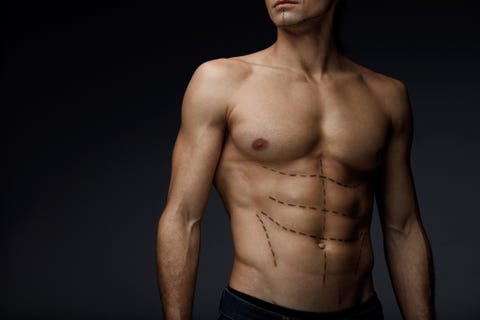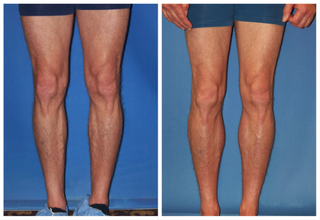
When he was 27, Al* had surgery to get an 8-pack. A former health care professional with a master’s in health science and research, Al took his fitness seriously, and spent hours working out in the gym. But he wasn’t achieving his desired results.
“Abs developed in the gym disappear very quickly. Even professional athletes don’t have cut abs if they don’t work on them specifically,” Al, who’s now 30, told MensHealth.com.
Al wasn’t new to muscle implant surgery: he had already had chest and bicep implants inserted before. So he decided to undergo abdominal implant surgery to get the body he’d always wanted.
Following the procedure, Al says his side effects were minimal. He was back to work in eight days and hit the gym after just three weeks (although he couldn’t work out the abdominal area for a few months). He’s still pleased with the results. “I’m extremely happy with [my] 8-pack,” he says.

Getty Images
Most guys want to be big. Most guys want to be muscular. Most guys want to look like they’ve logged hundreds of hours at the gym, even if they haven’t. And for some guys, the pressure to achieve a more muscular look is so acute that they’re willing to go under the knife to get it. These men are turning to plastic surgeons who specialize in bicep, pectoral, gluteal, and calf implants.
“[Muscle implants] are becoming more popular and in high demand,” says Dr. Douglas M. Senderoff, a Manhattan plastic surgeon who specializes in the procedure. “Male patients are trying to achieve a look that cannot be achieved by diet and exercise alone.”
The muscle implants are made of a semi-solid silicone elastomer, and are inserted either under the muscle lining or beneath the muscle itself. To perform a bicep or pectoral implant surgery, a surgeon will make the incisions in the patients’ armpits; for gluteal implants (or butt implants), the implant goes deep into the muscle, where the patient doesn’t feel it.
Costs vary, but data from the American Society of Plastic Surgeons states that pec implants start at around $4,196, while buttock implants start at $4,884. Data on the popularity of these procedures is scarce, as “it is [still] a relatively new and highly specialized procedure,” Senderoff says. But according to a report from the American Society of Plastic Surgeons, 987 men received pec implants in 2017.
That’s a small number, but Dr. Douglas M. Steinbrech, a plastic surgeon with offices in New York and Los Angeles, says that it’s growing. Between both of his practices, he estimates that he has seen a 437 percent increase in requests for muscle gel implants between 2013 and 2018, with pec implants being the most commonly requested procedure.

Not every guy who gets implants does so for purely aesthetic reasons. Dr. Sam Gershenbaum, a Miami plastic surgeon, estimates that about 35 percent of his male patients request muscle implant surgery for reconstructive reasons (for instance, if they had a previous botched surgery, or if they have Poland Syndrome, a disorder that results in one chest muscle being significantly less developed than the other).
As for the remaining 65 percent, Gershenbaum says that many of his male patients are slim or slight and are looking for more definition in their bodies, particularly if they find they can’t bulk up via diet and exercise. Genetics, for example, has been known to play a large role in an individual’s ability to build more muscle.
Surprisingly, however, “approximately 32.5 percent” of Gershenbaum’s male patients “are already muscular to varying degrees,” says Gershenbaum — and, like Al, they’re spending thousands of dollars to look even more jacked than they already are.

Like most cosmetic surgery trends, the rise of muscular implants can largely be attributed to the advent of Instagram, with its abundance of jacked guys showing off their gym bods, says Steinbrech.
“The landscape is getting more and more competitive between men [who want] big and ripped bodies,” he says. “Guys used to be shy about taking off their shirts. Now, with the seismic cultural change brought on by social media, a previously modest gymgoer may be almost completely naked on Instagram.”
Indeed, a recent Men’s Health survey revealed that one in three men aged 18-34 admitted to feeling pressure to look good on social platforms, while almost half of the men surveyed admitted to editing or cropping photos to make themselves look better.
“Guys used to be shy about taking off their shirts. Now, a previously modest gym-goer may be almost completely naked on Instagram.”
This pressure is arguably even more intense among gay men, who are more likely to hold themselves — and each other — to stringent body standards. Gay men are more likely than straight men to have disordered eating habits, negative body image, or body dysmorphia, a psychological diagnosis that refers to one’s preoccupation with a perceived defect or flaw with his or her physical appearance.
In an essay on body dysmorphia among gay men, Jeremy Bamidele writes that this may be due to the unique set of challenges that members of the LGBT community face growing up, such as being bullied or shamed for their sexuality. “Those on the outside of male society feel an even greater thirst to be the masculine ideal than those who belong,” he wrote.
For this reason, it’s perhaps not surprising that plastic surgeons say many of their male patients are gay men — and that many of them are requesting muscle implants in particular. Gershenbaum, for instance, estimates that gay men make up about 65 percent of his male patients who request pec implants.
For his part, Al strongly denies that he felt social or cultural pressure to go under the knife to obtain a jacked physique. “I haven’t felt any pressure at any point in my life,” he says. “However, the more I got exposed to more energetic, healthy people, the more I was attracted to their appearance…if you like worked-out guys, you have to be more worked-out yourself.”
Harris Van Cleef, a 52-year-old event production VP, is a bit more reflective about his motivations behind his surgery. He underwent a pectoral implant procedure in August of 2017. (Gershenbaum was his surgeon.) After working out for years, Van Cleef says he was frustrated that his chest did not get bigger alongside his calves and arms.
“Truthfully, I was self-conscious about my chest because it wouldn’t build,” he said. “As a gay man, I think I am more body conscious that the average guy. I hated dressing for summer. Nothing I wanted to wear looked great on me and I was so self-conscious about [wearing] fitted shirts.”
Van Cleef agonized over whether to have the surgery. “I thought long and hard about it and I researched like crazy to make sure I was making the right decision,” he said. “It was not an easy decision…I was very nervous that it would be botched, or that the implants would be too big.”
When he finally decided to go under the knife, Van Cleef says the procedure was painful, and it took about six months before he felt like the implants were fully integrated into his body. Nonetheless, he says he’s happy with the results.
“I have a partner of 16 years, so it was not so much about being appealing to other men,” he says. “It was truly about me feeling great about myself in any crowd.”

As with any surgical procedure, there are a number of health risks associated with muscle implant surgery, such as infection, adverse reaction to anesthesia, and swelling of clotted blood in tissues. There have also been a few cases of permanent muscle and nerve damage resulting from implant surgeries, though these are relatively rare.
Other potential complications include shifting of the implant, which can result in an asymmetrical look. In the case of one 44-year-old male patient, his left pec implant became displaced and swelled to the point that it was twice the size of his right, requiring him to have it removed.
If you are considering surgery, Van Cleef says it’s crucial to speak with former patients and choose a doctor who has a great deal of experience with the procedure. “Body implants are not something that a lot of doctors do frequently, so I made sure to choose a doctor that had done it hundreds of times and could show his work,” he says.
And if you don’t want to go digging deep into your pockets? Well, maybe it’s worth adjusting your expectations for what the perfect male body should look like.
*Last names have been withheld to allow subjects to speak freely on private matters.
Source: Read Full Article
